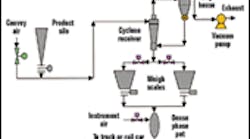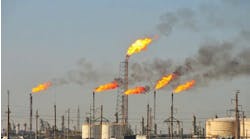Akzo Nobel's Pasadena, Texas plant produces fluidized cracking catalyst (FCC). The FCC produced at the plant is shipped to major oil refineries worldwide for use in their catalytic cracking processes. Catalytic cracking is an integral part of modern refineries and is of great importance to refinery operations. FCC is a dry granular substance and as such can only be transported practically by means of pneumatic conveying systems. Pneumatic conveying systems are used in many different industries to move dry products such as powders and pellets. Large blowers are used to generate air pressure in thin wall piping and tubing, and dry material is pushed or pulled through these pipes and tubes.Dry material pneumatic conveying systems differ greatly from the liquid and gas transport systems used in many process plants. These systems often present unique problems, especially with respect to process flow control. Process OperationAfter the FCC is produced, the final catalyst product is loaded through a vacuum conveying system at the plant. The vacuum system is used to pull the product out of the one of many silos and transfer it to one of two vessels mounted on load cells (Figure 1).Figure 1: FCC Transfer System
A vacuum system pulls the FCC out of the silo and transfers it to one of two vessels mounted on load cells. This process uses vacuum pressure to extract theFCC from one silo at a time.This process uses vacuum pressure to extract FCC from one silo at a time. The conveying air media must have a minimum take off velocity to adequately convey the fine powder catalyst through the system. From the selected silo, the powder is transferred into a cyclone receiver, and the powder then drops into a pair of weigh-scale hoppers. The scales work in tandem to drop the product into a dense phase pot. The dense phase pot continuously cycles to fill, pressurize and convey. The product is then blown into either a rail car or truck.Akzo Nobel's vacuum conveying system is controlled by an Allen-Bradley PLCs and a Wonderware HMI. Even with these relatively sophisticated control components, the process remained semi-manual due to various control difficulties. These manual operations were time consuming and made it harder for operators to accomplish other product and raw material transfer tasks.Process operators also had to continually adjust silo discharge and aeration valves to maintain product transfer rates and prevent plugging. Plugging occurred when the take-off velocity of the convey air decreased. This usually was caused by a restriction upstream of the silo, or a sudden product break in the silo and the subsequent rush of powder into the convey line.The PLC control logic has several process interlocks to insure that the system does not exceed vacuum limits or exceed 5,000 pounds at either weigh vessel. When a process interlock is activated, the silo discharge valve closes and shuts down product transfer. If interlock trips occur frequently, product transfer rates are negatively affected. We found that vacuum pressures between 7-9 in./Hg (or 95 -122 in./H2O) result in optimal transfer rates for our system.Control Problems and ObjectivesControlling the process is a major challenge because there are many process variations including product type, settling or fluidization characteristics, silo distance from the weigh scales, and interior vessel wall slippage.When process conditions are perfect, product flows out of the silo at rates of 1,100 lb/min. continuously at a fixed silo discharge valve position. This perfect-state condition seldom lasts for very long as any number of process variations can occur at a given instant. Some of these process variations may include lack of proper air fluidization of the product in the silo, changes in instrument air pressure, and sudden changes in bag house differential pressure. In addition to these instantaneous process condition changes, changes in silo wall slippage, changes in control delay times, and changes in mean silo discharge valve position can also occur from transfer to transfer. With these unpredictable differences in process dynamics, classical PID control implemented through the PLC failed. A more adaptable control solution was required to improve the automation of the process stream. MFA ImplementationBecause the vacuum pressure in the transport pipes has a tremendous effect on the material flow, it must be tightly controlled. Depending on the location of the silo in use, there is a variable transport dead time in the process of 1-5 minutes. This long and varying dead time made it almost impossible for the PID controller to keep the vacuum pressure from oscillating. Consequently, the system was always flooded (too much material) or starved (not enough), causing periodic slowdowns and loss of efficiency. It was time to take care of these control problems once and for all. Akzo Nobel's process engineers decided new control methods were needed. So, faced with a major control problem in the FCC transfer system, it was only natural for the company to consider a MFA-based control solutions using Model-Free Adaptive (MFA) controllers. Ultimately CyboSoft (www.cybosoft.com) MFA controllers were chosen to manage the pH control systems. With CyboSoft's CyboCon software, there are a number of MFA controller options available and each one is designed to solve a challenging control problem. For instance, Nonlinear MFA controls nonlinear processes, MFA pH controls pH processes, and MIMO MFA controls multivariable processes.The Anti-delay MFA controller was selected to control our process because of our system's long and varying transport delays. Since there was no need to build process models, it was relatively easy to configure and launch the MFA controller.Launching the Anti-Delay MFA ControllerLike the vacuum pressure control loop in our logistic system, many industrial process control loops have large time delays due to transformation of heat, materials and signals. No matter what control action is taken, the effect may not be measurable for a period of time. This is equivalent to disabling the feedback, and feedback information is essential to automatic control.If a PID is used to control a process with significant time delays, the controller output will keep growing during the delay time and cause a large overshoot or make the system unstable. Typically, a PID has to be de-tuned significantly in order to stay in automatic mode, but this action sacrifices control performance. When a controller is de-tuned, poor and sluggish control performance occurs and the set point can significantly diverge from the process variable. Smith Predictor is a useful control scheme to deal with processes with large time delays. However, a precise process model is usually required to construct a Smith Predictor. Otherwise, its performance may not be satisfactory. Since the Anti-delay MFA does not need a precise process model, it can be easily configured with an estimated process time constant and process delay time. In this application, an estimated 30sec. time constant and a 140sec. delay time was used. As in most processes, Akzo Nobel's engineers understood that there would be a mismatch between the configured and the actual process delay time. Since MFA adapts, it can deal with the difference. Once MFA was configured, the controller was launched and it successfully took over control immediately.Better Control, Higher Yield, Less WasteMFA controllers can control complex systems and, unlike model-based control, do not require custom configuration of process models.Starting from the same oscillating control condition, the system oscillated under PID control, while the MFA system was able to quickly adapt to an excellent control condition. If both controllers were started from a sluggish situation, it was clear the MFA system controlled the process faster and better than the PID-based system. Better control means improved process stability, higher production efficiency and yield, consistent product quality, and reduced material and energy waste.Akzo Nobel's Pasadena, Texas plant has deployed multiple MFA controllers for vacuum pressure control in our catalyst logistics plant. We have also deployed multiple MFA pH controllers for wastewater neutralization in our catalyst production plant. These MFA controllers have proven effective and user-friendly with no process models or manual tuning required. Akzo Nobel has improved production efficiency, reduced material and energy consumption, and achieved a significant return on investment since implementing MFA.References[1] George S. Cheng, MFA in Control with CyboCon, CyboCon MFA Control Software User Manual, CyboSoft, General Cybernation Group Inc., Rancho Cordova, CA, 2002. [2] Vance VanDoren, Techniques of Adaptive Control, Elsevier Science, Butterworth-Heinemann, Burlington , MA Europe , Cahners Europe, Brussels , Belgium Pasadena , Texas. His primary responsibility is process control applications and systems for the site. He has 17 years of experience in process control. He holds a B.S. in Chemical Engineering and an M.B.A., both from the University of Houston



